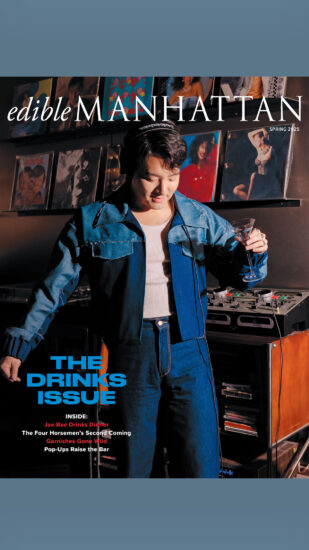
There’s some strange and delicious magic happening in the basement at the Standard East Village. That’s because the Standard’s creative director of food and culture, Angela Dimayuga, has brought in flavor scientist Dr. Arielle Johnson—who is known in the upper strata of the cutting-edge fine dining world as a secret flavor weapon—to develop fermentation boxes to fit into a sliver of a space next to some metro shelving. What she and Dimayuga will come up with alongside Standard East Village chef de cuisine Max Blachman-Gentile might just expand New Yorkers’ palates beyond pickles and miso.
The 32-year-old director’s fellow at the MIT Media Lab has headed up research and development for Noma in Copenhagen, made miso out of just about anything for Momofuku Lab in NYC, advised on funk at L.A.’s Sqirl and, in addition to consulting for José Andrés and Alton Brown, is currently working on a book titled Flavorama: The Unbridled Science of Flavor and How to Get It to Work for You.
Read more: Tips for Starting a Fermentation Habit


Having made misos from the restricted range of Scandinavian grains and legumes, she is understandably excited to experiment with local ingredients from the nearby Union Square Greenmarket and is collecting data on how they each react to lacto-fermentation. The team’s dream, Johnson says, is “expressing the New York region’s ingredients through this lens of fermentation—to give a sense of place but also broadening the palate of flavors that the kitchen has to work with.” Johnson also wants to refine these new and different fermentation styles so that they’re more predictable for cooks.
While playing around with MIT’s as-high-tech-as-possible controlled environment mini labs and other prototypes, she also created more stable, robust and practical models with parts anyone can find on Amazon. They’re meant more for restaurant kitchens like at the Standard East Village where she’s already making two that fit the needs of their food-and-beverage outlets. “There’s something fun and punk rock about building these things, not out of garbage but out of discarded things,” says Johnson. She also put in a commercial dough proofer that holds koji ferments—i.e., ingredients transformed by a bacteria typically used to make miso, soy sauce and sake—at just the right temperature and humidity level.


Misos, vinegars and lacto-fermented pickles are just some of the things that can come out of the boxes, while the proofer will be home to experiments in making misos and soy sauce from New York–grown buckwheat, rye, spelt and more. Johnson is also eager to play with the 40 pounds of mushrooms that are being harvested from the Smallhold indoor mushroom farm, built by the Brooklyn company whose fungus farms can be found in Whole Foods and Mission Chinese Food, that was installed above the bar in the hotel’s restaurant, Narcissa. “They have earthiness and umami, especially if you lacto-ferment them, which brings in saltiness and acidity,” she points out. “That’s like every note you want to have in a condiment!” She starts imagining the possibilities: “Oyster mushrooms, if you smoke them and then lacto-ferment them, are delicious!”
Read more: The Art of Secondary Fermentation
Johnson’s collaboration will yield deliciousness but also data. “Something I’m interested in now—this is the maximalist, data-gathering scientist part of me—is this big survey of as many things as possible. Not only ingredients but also things like lactic fermentation of plant material. We know from around the world that it works very well on cruciferous vegetables and things like that, but why are there not more fruit lactic ferments? You have preserved lemons, such as chanh muôi in Vietnam, and plums get fermented a lot, but what can we do to make this delicious flavor palate of fruity things more complex and available for sour applications?”

Some of this experimentation will funnel into Flavorama, which will be published in 2021. “I’m just trying to get a better understanding of why things work the way they do,” she says. “There’s an interplay between salt levels and moisture levels and sugar that, if you can hit it at the right sweet spot for a given ingredient, you can do very sublime things with it.”
Between projects like the Standard East Village and her upcoming book, Johnson hopes to help mainstream fermentation. Not in the sense of dumbing it down, she insists, but “just getting it more out in the open and less mysterious. Because,” she emphasizes, “it’s part of our shared human heritage.”


